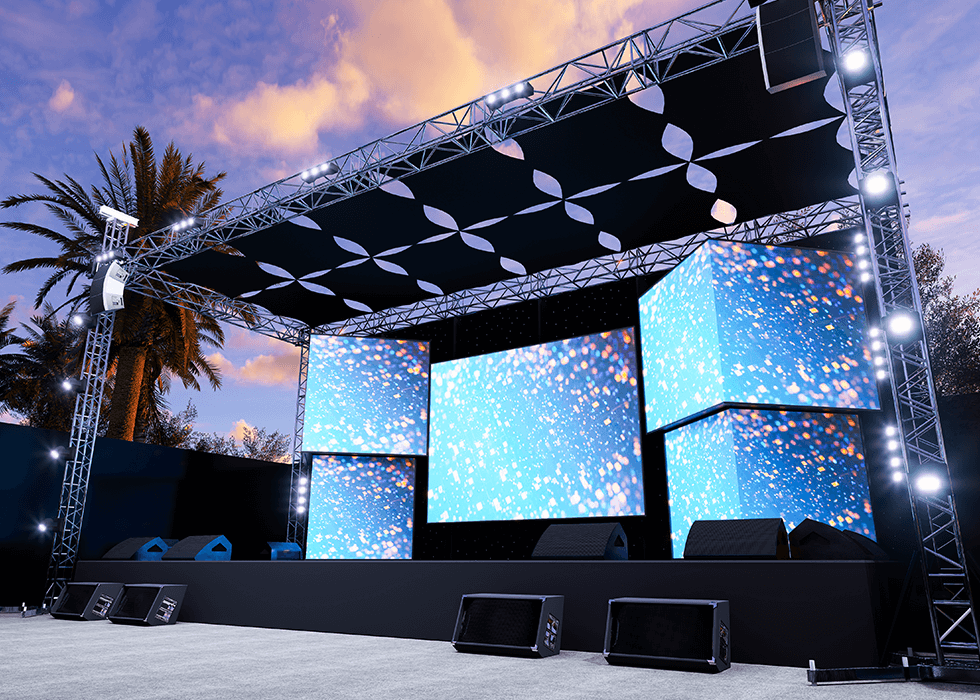News & Trends
The Journey to ATSC 3.0, with Pro AV and Digital Signage Implications
Video

For this document, our objective is to explore the evolution of broadcast video standards, and most importantly, where we are today with the launch of the ATSC 3.0 standards, and the implications this has for pro AV. I know that some will immediately “switch the channel” at the mention of broadcast TV standards... after all, what does consumer broadcast television and over the air standards have to do with pro AV? That is all about sitting at home on a couch, antennas, and reception, right? Well… not so fast! The correct answer for those still with us, is that ATSC 3.0 can be relevant to pro AV in a potentially meaningful way. With that in mind, stay tuned (pun intended)!
The FCC
To keep score here, we need to know about the two major players in the over the air game. Let’s look from the top down. We the people “own” the airways in the USA, and the Federal Communications Commission (FCC) is the arm of government who regulates the use of that airspace. The FCC regulates interstate and international communications by radio, television, wire, satellite, and cable. It is an independent U.S. government agency overseen by congress with primary authority for communications law, regulation, and technological innovation. The challenge for the FCC is that it does not begin and end with technology. Its work encompasses facing economic and social opportunities and challenges associated with rapidly evolving advances in global communications. As stated in their charter, their mandate embraces:
- Promoting competition, innovation and investment in broadband services and facilities
- Supporting the nation's economy by ensuring an appropriate competitive framework for the unfolding of the communications revolution
- Encouraging the highest and best use of spectrum domestically and internationally
- Revising media regulations so that new technologies flourish alongside diversity and localism
- Providing leadership in strengthening the defense of the nation's communications infrastructure
For our purposes here, the FCC approves and oversees broadcast television and all the factors that evolve out of that medium. If this and all the attendant variables appear complex, then you have named that tune in one note.
ATSC
The next player in this saga is the Advanced Television System Committee (ATSC). This is an international nonprofit organization formed to develop technical standards for digital terrestrial television and data broadcasting. ATSC's 120-plus member organizations represent the broadcast, broadcast equipment, motion picture, consumer electronics, computer, cable, satellite, and semiconductor industries. ATSC was initially formed in 1983 to develop a first-generation digital television standard that could replace existing analog transmission systems. The new (at the time) digital system became known as "ATSC 1.0." ATSC 1.0 is in use in the United States, Canada, Mexico, and South Korea. ATSC then developed a next-generation digital television standard known as "ATSC 3.0.” You may have heard this referred to as NextGen TV… this is simply the Consumer Technology Association's (CTA) marketing name for the new ATSC 3.0 standard. This was first commercially deployed in South Korea in May 2017, and was approved for voluntary use in the United States in November 2017.
Of course, I must include a bit of history for context. Do you remember back in 2009, when anybody using a TV antenna had to switch to the new digital system? That was the change from analog UHF and VHF channels to ATSC 1.0… which by the way was originally introduced way back in 1995. This shifted TV broadcasts from a raw analog signal that was fed straight to the TV’s tuner, to a digital one that allowed for compressed video and additional data. That, in turn, allowed broadcasters to offer an over-the-air signal while using less spectrum, and introduced some features we now take for granted, like full-HD (1920 x 1080) resolution, surround sound, and digital-closed captioning. Wondering what happened to ATSC 2.0? Yeah, good question! It was basically outdated before it had the chance to launch. All of the changes that were added to the ATSC 2.0 proposal have been integrated into ATSC 3.0.
The switch to ATSC 3.0 is the first major upgrade to broadcast standards since 2009, but unlike the move to digital, which introduced relatively minor changes to the actual content and viewing experience, ATSC 3.0 opens the door to several significant changes and enhancements. The new ATSC 3.0 standard takes everything about the initial migration to digital TV broadcasting in ATSC 1.0 and upgrades it.
Among the improvements offered by ATSC 3.0 are:
- Signal quality:
- Overall, there is better signal quality (i.e., integrity) with less interference. One of the biggest issues with ATSC 1.0 is that the digital signal is fragile. The VHF band used is prone to interference from buildings and trees, weather and even passing cars, and the digital data it sends is easily corrupted, which shows up on your display as a blocky, unwatchable picture, or even just a "no signal" message. With ATSC 3.0, broadcasters are switching back to UHF and employ Orthogonal Frequency Division Multiplex (OFDM) as part of its core encoding, compared to the 8VSB encoding used for ATSC 1.0, which means that the transmission and reception of ATSC 3.0 content should encounter far less interference than older 1.0 broadcasts. OFDM is the methodology behind the latest Wi-Fi and mobile wireless technologies. It's a more robust method for transmitting digital information, and when combined with the switch back to UHF, it will let local TV stations offer a clearer signal with broader reach and fewer interference issues.
- Image quality:
- The most visible benefit is picture quality. While the current ATSC 1.0 standard caps out at 1080i, the new standard allows for 4K UHD broadcasts and potential for 8K in the future. Other picture quality upgrades include:
- High dynamic range (HDR) which equates to the difference between how dark and how bright the picture can get.
- Wide color gamut (WCG) or an increased range of colors (see Rec.2020 compared to Rec.709)
- High frame rate (HFR) content (above the typical 60Hz) which gives a much smoother image compared to 24fps cinema or 30fps for video. It's capable of showing up greater detail within scenes and it can significantly reduce latency.
- Bit Rate:
- The new standard also packs much more data into the broadcast signal, ramping up from the single static 19.4 Mbps bitrate of the ATSC 1.0 standard to a variable bitrate of up to 57 Mbps using the same airwaves.
- Video codecs:
- ATSC 3.0 isn’t married to a single video format. Right now, ATSC 3.0 uses the H.265 HEVC codec for video delivery because of its efficiency gains over the much older H.262 MPEG-2 codec used in ATSC 1.0. Over time and through upgrades, it will be able to adopt newer codecs like the recently finalized H.266 VVC codec, which is the leading candidate to usher in 8K when that time comes.
- Audio quality:
- Audio quality is being improved, with support for Dolby AC-4 and MPEG-H 3D Audio formats. These are both multichannel audio formats, with support for surround-sound multi-speaker setups and even 3D object-oriented sound for a much more immersive audio experience. The older ASTC 1.0 standard supports 5.1 surround sound, but the ATSC 3.0 system allows for up to 7.1.4 channel support and formats like Dolby Atmos can be offered over the air. The multiple audio streams will also offer customization options, such as multiple languages and video-description services for the visually impaired.
- IP delivery:
- ATSC 3.0 combines broadcast TV with broadband internet. It can push huge volumes of data over its broadcast signals. That’s how it can scale picture and audio quality up to 4K HDR and beyond Dolby Atmos. However, it turns out that the same bandwidth can be used to deliver a wide range of digital information that goes well beyond the ones and zeroes needed for television. Since ATSC 3.0 uses Internet Protocol (IP) to deliver its A/V signals, it can broadcast any other kind of IP-based data, too. Keep in mind that ATSC 3.0’s datacasting is one-way only, which means it can’t act as a substitute for your home or mobile internet data plans. Still the possibilities present with IP-based datacasting are intriguing. Datacasting over ATSC 3.0 could massively expand these scenarios without the corresponding data fees that most of us pay for this kind of data delivery.
- Availability and analytics
- ATSC 3.0 makes for availability and a corresponding ability for analytics on many more devices. It also allows for interactive features, customizable content, addressable advertising, etc. The broadcast world now enters the domain of cable and streamers, and that will shake things up considerably on the business side.
- The most visible benefit is picture quality. While the current ATSC 1.0 standard caps out at 1080i, the new standard allows for 4K UHD broadcasts and potential for 8K in the future. Other picture quality upgrades include:
The first tests of ATSC 3.0 began a decade ago. The FCC gave the go-ahead (but there was no immediate implementation mandate) for the new standard in 2017, and local broadcasters have gradually been adding ATSC 3.0 feeds ever since. The FCC currently mandates that stations transitioning to ATSC 3.0 keep their legacy signals up and running for at least five years, but it could extend that timeline. One reason for this is that the FCC decided against a hard transition to ATSC 3.0 that would have left everyone without a compatible device in the dark. Alex Siciliano, a spokesperson for the National Association of Broadcasters (NAB) explained “We have to both offer our current services (ATSC 1.0) while also offering the 3.0 signal,” and in early 2023, broadcasters were utilizing ATSC 3.0 in around 50 local markets. By the end of the year, 75 percent of US households will have access to ATSC 3.0.
While the advances of ATSC 3.0 are significant most people aren’t currently able to watch over-the-air broadcasts in ATSC 3.0, even if they live in a market where it has been rolled out. While any existing antenna can receive ATSC 3.0 signals, the same isn’t true for TVs. ATSC 3.0 is not backward compatible with ATSC 1.0, the current broadcast standard, and most existing TVs can only receive ATSC 1.0 signals. This requires purchasing an external converter box or buying an ATSC 3.0 capable TV to use these features.
For those who still have not “switched the channel”, and are still reading, there are several overarching points that I feel are noteworthy.
- At the top of this list is the inherent architecture and makeup of ATSC 3.0 and its ability to evolve in the future. Without going into deep technical terms this refers to the way ATSC 3.0 is constructed, enabling advances to be facilitated. To the IT literate think “open architecture”. In simpler terms, it should be capable of including extensions such as 8K distribution as but one example.
- Efficient delivery of IP content: One of ATSC 3.0’s benefits is that its one-to-many infrastructure makes it more efficient than broadband’s one-to-one design, enabling broadcasters to send data to multiple users at the same time with a single signal.
- Nationwide coverage can more easily be achieved more rapidly and cost effectively than broadband providers by leveraging and upgrading existing broadcast infrastructure with ATSC 3.0 transmitters. This will provide reliable internet content to most Americans without laying new fiber or building new wireless towers. As one expert notes. “this overcomes the digital divide with an infrastructure that already reaches underserved communities.”
- Think emergency notification and an existing infrastructure that is resilient. With broadcast towers there is redundancy built into multitower networks in every US market, dramatically increases the likelihood that broadcast transmissions remain operational following catastrophic events. With ATSC 3.0 update this opens the possibility for advanced emergency alert information through broadcast and/or broadband. The types of media that could be pushed include evacuation maps, images associated with AMBER alerts, weather radar maps, user-generated videos and possibly even the ability to “wake” sleeping devices during dangerous situations.
Okay so now you are up to date on the ATSC 3.0. One broadcast expert likens this “to broadcast television what 5G was to mobile a few years ago: a mixture of buzzwords and real innovation, something that’s definitely coming, but no one really quite knows yet what its true impact will be. And on paper, there’s a lot to like about it: the standard allows broadcasters to transmit TV signals with up to 4K HDR and better audio. ATSC 3.0 also includes data transmission features for better program guides, interactive apps and, eventually, advertising services.”
Well said… but now as the iconic broadcaster Paul Harvey used to say, “Now for the rest of the story”. In our case (meaning pro AV and digital signage) the “rest of the story” is all about AV over IP. I have written extensively (for over 25 years) on the famous (or some say infamous) convergence of AV and IT. While there are still some holdouts, the fact is these truly have converged. AV resides increasingly on an IT backbone. As this has evolved, the concept of AV over IP has taken on a life of its own. This is where ATSC 3.0 becomes meaningful to us. We will have access to a new technique of streaming signals, one to many, that is high quality in both video and audio and wrapped in the arms of great signal integrity. Perhaps the best news is that it is IP capable. This is one of those times that begs for creative thinking on the part of the broadcast industry as well as those in AV design/integration, and digital signage. It begs the question of what may be possible with this new and much more robust and capable method of signal transmission. We should say in unison, “New opportunities and new business models… hooray!”















